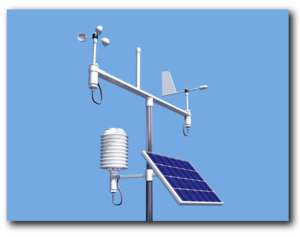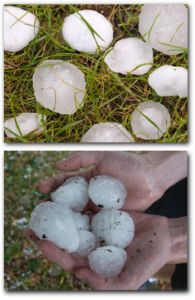Authors: Michelle Bradley, ACAS, MAAA, ARM, CERA, Scott Kehler, M.Sc., and Mike McAndless, B.Sc., CRM
SIGMA and Weatherlogics were recently introduced to each other by Mike McAndless, who worked with Michelle Bradley on a project in the mid 1990’s. This project was based on a key recommendation for a company seeking listing on Canada’s Toronto Stock Exchange. One of the five material guidelines at that time encouraged that Directors of listed companies “ensure that the principal risks of the organization were identified, and processes were in place to manage those risks”1
This required the initiation of a robust process to identify the principal risks and evaluate the impact they had on the company. In many ways, the process followed by the company served as one of the first practical applications of what would later become the discipline of ERM, or Enterprise Risk Management, as the risks being evaluated and managed were expanded to operational areas that were historically never involved in the traditional risk management process. We will deal more specifically with the area of ERM in a future blog.

The type of weather station and its location are important to ensure the precision and accuracy of the data.
After an inclusive risk identification and qualification phase, the company ranked weather risk as being the most significant risk to their revenues. The company and its advisors then went about searching for a solution with the knowledge that they couldn’t necessarily “manage” the weather, but that they may be able to mitigate its financial impact. This lead to an integrated insurance/risk financing vehicle that was largely related to drought. In order to evaluate and ultimately price such a solution, the company and its advisors had to depend on large and lengthy weather data sets from a variety of sources. Unfortunately, the process of handling weather-related data was still relatively immature at that point, so the data sets were subsequently found to be less than perfect.
Even today, companies are searching for ways to address and mitigate weather risk with insurance and other alternative risk financing programs. In a SIGMA blog posted in late 2015, we discussed the trend in captives to insure non-traditional risks. At the time of that blog’s posting, approximately 40% of the captives that SIGMA was involved with insured at least one non-traditional risk. As predicted, that figure has increased to around 50%.
Many captives insure risks related to property coverages or stand-alone, weather-sensitive coverages. Property coverages relating to named storms, convective storms, and hail are often insured in captives on a deductible buyback basis, but they can also be covered through parametric insurance. Parametric insurance does not indemnify the actual loss, but generally pays out a fixed amount in the event of a specific trigger. For example, if a Category 4 named storm hits a certain location (within a specific mile radius) the contract would pay a specified amount.
Regardless of the insurance or risk financing mechanism being used, weather risk poses distinct actuarial analytical concerns. From a data perspective, most companies fail to maintain internal records of specific weather risks and how those affect revenue or tangible assets. As such, industry data related to the weather event or risk and limited internal information will normally be compiled as a first step. From there, an actuary may determine a frequency and severity for the event or risk as well as the associated estimated statistical distributions of each based on the available data.
Once this has been completed, a company can project their expected annual (or contract) losses by multiplying the expected frequency of the event by the expected severity. While most insurance risks feature an expected frequency greater than one, the frequency of weather risks is generally less than one, depending on how the associated contract is structured. In the named storm example above, the probability of a Category 4 named storm hitting the location may be 5% (or .05), meaning that it is expected to occur once every twenty years. The frequency and severity distributions can also be used to model the risk and determine confidence levels associated with the projection. This modeling process can also help review probable maximum losses or approximate worst case scenarios in low frequency/high severity risks. In cases where the weather risk and contract structure are especially complex, advanced modeling and data-gathering by a firm such a Weatherlogics would be essential in determining a sound loss projection. Companies seeking this additional analytic work typically begin the process by working alongside the weather consulting firm to determine the specific weather risk (or risks) requiring mitigation.
Once a particular weather risk has been identified, attention then turns to selecting an appropriate dataset of historical climate data to assess the risk. While this may seem like a trivial task, it can actually become quite complex. One of the first considerations has to be the source of the data. Did the instrument used to measure the weather conditions conform to international standards, such as those developed by the World Meteorological Organization, or were the measurements taken by non-standard equipment? This is critical, since some measurements, such as wind, are highly sensitive to the siting and height of the measurement instrument. Furthermore, measurement techniques can vary over time, which can alter the characteristics of data. One common example of this is snow measurements. In the past, before automated weather stations were invented, snow was always measured by a human observer. Since the inception of automated stations, the process of measuring snow is often performed using digital instrumentation. This change in measuring techniques can introduce systematic biases that may not be easily detected, and could be falsely attributed to climatic changes, rather than changes in measurement techniques.
Once a reputable meteorological data source has been compiled, the data must be thoroughly quality-controlled. A dataset may have been generated by a reputable weather station, but that does not guarantee the quality of data. With tens of thousands of weather stations worldwide, producing millions of data points daily, erroneous values frequently find their way into otherwise reliable data. In Canada, the National Climate Archives are a primary source of climate data. However, due to changes in quality-control practices over the years, much of this data now only undergoes limited quality-control. Weatherlogics has recognized the need to repair this data and has already developed a process to identify and correct errors. The number of erroneous measurements in the National Climate Archives can number anywhere from hundreds to thousands for a single weather station.

Ground measurements of hail are the most accurate way to confirm hail size.
Lastly, once a weather event has occurred, additional weather data may be needed to verify the intensity or severity of an event. Again, it is critical to identify a reputable data source for verification. One example of a difficult phenomena to verify is convective storms that produce hail. Hailstorms are frequently verified using radar-derived maps of hail swaths. While these maps can be a useful tool, it is important to recognize that weather radar does not directly measure hail. As such, these maps are only estimates of hail occurrence and can be subject to errors both in size and location. Weatherlogics has developed a database of real hail measurements which can be used to supplement hail maps produced by radar. This database contains actual ground-measured reports of hail, including size, time, location, and precision anywhere across Canada and the United States. By combining these actual measurements of hail with radar-derived estimates, verification is made more accurate. In short, meteorological data must undergo thorough verification before being used to assess weather-related risk.
The decision to mitigate weather risk for your company is always an easy one. However, the process of properly identifying and analyzing the key weather scenarios, as well as developing the appropriate and cost-effective risk-control response, can quickly become complex and overwhelming. Understanding the details behind weather risk and following the step-by-step analytical outline this blog sets forth are vital steps in determining the best mitigation approach for your company. Alongside this, utilizing the analytical capabilities of SIGMA and Weatherlogics can help ensure the risk mitigation decision is based on firm, data-driven analysis, irrespective of the type of risk transfer involved.
1 Source: Where Were the Directors? — Guidelines for Improved Corporate Governance in Canada in December 1994
We welcome your feedback by posting a comment or contacting the authors below:
L. Michelle Bradley, ACAS, MAAA, ARM, CERA
Consulting Actuary
Email: mb@sigmaactuary.com
Since 2003 Michelle has been a Consulting Actuary at SIGMA Actuarial Consulting, Inc. She is an Associate in the Casualty Actuarial Society and is a Member of the American Academy of Actuaries. She also obtained the Associate in Risk Management designation in 1996 and received the award for academic excellence in that program. She served as president for the Casualty Actuaries of the Southeast for the 1999-2000 year. From 1990 to September 2003, she was Vice President and Consulting Actuary for Willis Risk Solutions of Willis North America. During this time she consulted extensively in the areas of actuarial, risk management and enterprise risk management. Michelle received the CERA (Chartered Enterprise Risk Analyst) designation in 2013. She has served on the board of directors for the Society of Risk Management Consultants, the Casualty Actuaries of the Southeast, and the Hawaii Captive Insurance Council (HCIC). She also serves on the Advisory Council for Middle Tennessee State University’s Master of Science in Professional Science Program (MSPS).
In the area of enterprise risk management, she has focused on modeling issues as regards integrated programs that often include non-traditional risks. She has significant expertise in risk mapping and alternative risk transfer mechanisms. She has been a member of numerous project teams that provided enterprise risk consultancy services and was part of the project team that completed the integrated program that was hailed the “Deal of the Decade” by CFO Magazine (June 2000).
Michelle has spoken at numerous treasury and risk management conferences and published several papers with external publishers. She has also completed actuarial, risk management and special consulting projects for numerous clients in varying industries. These include allocation analyses, retention analyses, and risk management organizational audits. Additionally, Michelle has been involved in “letter of credit” negotiations and commutation analyses and has served as an expert witness.
Prior to joining Willis, Michelle attended Vanderbilt University, where she taught mathematics courses while pursuing a Master’s Degree. In 1990 Michelle was awarded the Outstanding Graduate Student teaching award for the College of Arts and Sciences and received the M.S. Degree in Mathematics. Michelle graduated summa cum laude as valedictorian from Lipscomb University in 1988, receiving a B.S. Degree in Mathematics.
Scott Kehler, M.Sc.
Chief Scientist
Email: scott@weatherlogics.com
Scott is the President and Chief Scientist of Weatherlogics. He received his Bachelor of Science from the University of Manitoba, where he completed the Honours program in atmospheric science. His Honours thesis presented results from high-resolution model simulations of lake breezes in Manitoba and their relation to weather. Following the completion of his Bachelor’s degree, Scott undertook master’s studies at the U of M, focused on researching nocturnal thunderstorms. His research was based on data collected during the Plains Elevated Convection at Night (PECAN) field campaign based in Hays, Kansas in 2015. Scott successfully defended his Master’s Thesis, which contributed to improved understanding of why thunderstorms form at night. His research and collaborations have appeared in atmospheric journals such as Atmosphere-Ocean and Boundary-Layer Meteorology.
In his current role as Chief Scientist at Weatherlogics, Scott conducts meteorological research to assist clients. His work mainly focuses on new methods to improve weather prediction and studies of past weather events. Despite his research focus, Scott still enjoys forecasting day-to-day weather and is often involved with preparing forecasts for high-impact events.
Mike McAndless, B.Sc., CRM
Business Mentor and Project Lead
Email:mjmike48@shaw.ca
Mike's career in the field of risk management spans over 35 years, the majority of which were spent Chief Risk Officer of Agricore United/United Grain Growers. He currently provides mentoring advice via Canada’s “Futurepreneur” Program to early stage businesses. One such business is Weatherlogics Inc. located in Winnipeg, Manitoba.
© SIGMA Actuarial Consulting Group, Inc.
